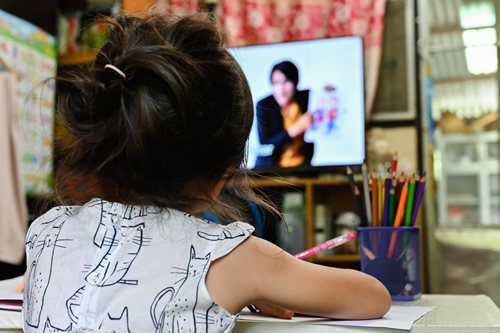While families have had to wait out a once-in-a-lifetime pandemic, I could not help but think about our most at-risk students–those with the least resources, the biggest gaps, and the largest hurdles.
Unfortunately, many of these children are already at a significant disadvantage. They are disadvantaged children without the same resources as other children. Therefore, it is not only important to help them; it is our responsibility as educators to do something about this gap.
Related content: Using summer to help teachers prepare for fall
In quarantine, the gap widens. My greatest fear: these children need the most support, yet are farthest from our reach. How could we possibly find alternatives to help them and in so doing, close the gap? I discovered one. Teach kids on TV-PBS–through New Jersey’s incredible innovation, we brought instruction to 100,000 of our most needy children.
I submitted a proposal to present to middle school students from across the state of New Jersey, and discovered that my lesson submission had been accepted to be produced! Thinking about those children, trapped in their homes with little exposure to outside learning experiences, I eagerly planned my lesson, which aired on PBS.
I was inspired during lockdown. One hundred thousand students typically viewed these online lessons, many in homes where digital access was limited. Teaching a lesson on TV had the potential to re-energize students’ spirits, show them that as a principal, I was first a teacher, and that if I expected them to transform to digital instruction, I had a responsibility to model the way. The experience was grueling–and inspiring.
My daughters post to YouTube and Instagram, and use tools like iMovie and Windows Movie Maker. I have dabbled but never before had I combined planning a lesson, producing a video,and formulating an hour long lesson, all for TV! This was a project that I stumbled around learning, in the hopes that you wouldn’t have to.
I am excited to share the ideas I learned about with everyone involved in teaching digitally. That’s just about all of us in education. We should use experiences gained for better instruction, particularly for those who need it most, and have the least amount of access. Here are some of the ideas you can use when producing a video lesson.
First, be prepared to incorporate quality screencasting. Most of us have figured this out. My favorite is Loom, which stores your files online for free and makes it easy to post to YouTube, and other platforms, as well as to share video in Google Classroom.
Second, think about using an online teleprompter. They are everywhere and easy to use. If you are teaching a mini lesson, or need to spend a few minutes explaining an important concept, consider drafting a script, and teleprompt it. You can change the speed and size within these programs. Use an iPad or second computer to see better. Then video from your phone, placed strategically on top of the teleprompt. This helps to make it appear more natural when reading a script!
Third, don’t try to video the whole lesson in one shot. Use a program like iMovie, or Movie Maker slide video clips in, out and around. These are designed to adjust. It takes some getting used to but I found resources like YouTube how-tos (and my daughters!) very helpful.
Fourth, include props, even family members if they are willing. This is fun and engaging, and helps to change the tempo, which kids like and helps with engagement.
Fifth, have fun and take breaks. Don’t take yourself too seriously. I was reminded, “Remember, you are talking to kids!” Teaching to a camera, imagine your students instead. Sometimes, developing a lesson doesn’t work, your internet is down, or kids are screaming. Give yourself breaks and time. Developing video and online lessons is fun, but challenging. You will get frustrated without recognizing the humor and learning curve in it.
Finally, remember that part of teaching is making it engaging. Resources like Kahoot! and random lotteries worked in class. Bring them to digital learning. If you are teaching video lessons, entice your students with “lotteries” and high interest gamifying of lessons. I use a random lottery wheel, which spins with excitement causing students’ interest to pique.
Bottom Line: Make the best of using video to bring your lesson to your students to close the gap, and have fun doing it!
- 5 obstacles AI can help schools overcome - April 16, 2024
- Guidance counselors could help female high schoolers erase the STEM gender gap - April 16, 2024
- How video coaching inspires teacher self-reflection - April 15, 2024

